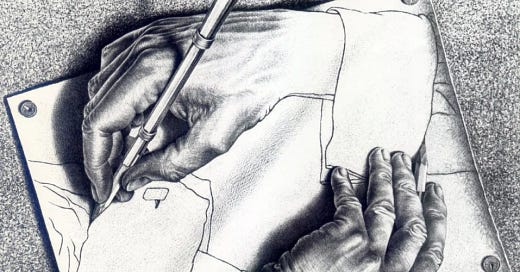Transcending Duality Through Art: Escher and the Non-Dual Vision of Vedanta.
The creative paradox as a path to grasping the Absolute.
The painting "Drawing Hands" by Maurits Cornelis Escher can be an effective visual metaphor for some key concepts of the philosophy Vedanta, in particular the relationship between Atman and Brahman. This work depicts two hands that are drawing each other, in an infinite loop of cause-effect that creates a visual and conceptual paradox.
Similarly, in the perspective of Vedanta the Atman, the individual Self, and the Brahman, the universal Self, are two realities that appear distinct but are inextricably connected and interdependent. Like Escher's hands, the Atman and the Brahman are different aspects of the same ultimate Reality, which transcends the dualistic categories of the human mind.
The Vedanta affirms the "substantial identity" between Atman and Brahman: the individual Self is nothing but a manifestation of the Cosmic Self. As Shankara, the most important exponent of the school Advaita Vedanta, writes: "Brahman is Real, the world is illusory, the Atman is Brahman."
However, identity does not imply indistinguishability. Atman and Brahman are One and Other at the same time. They are like the two sides of the same coin, or precisely like Escher's hands, which by drawing each other create an unbroken mutual reference.
Therefore, Atman is identical to Brahman but at the same time constitutes its particular individualization. It is like a drop that contains within itself all the qualities of the ocean while maintaining a specific delimitation. The analogy with Escher's drawing highlights this "holistic" quality of the perspective Vedanta.
The metaphor of the hands drawing themselves also expresses the active role of the individual in shaping their own reality. Through knowledge and spiritual practice, we can awaken awareness of our true nature as Atman-Brahman. Like fingers tracing lines on paper, we can "draw" our path to liberation.
In brief, the visual paradox created by Escher provides an evocative representation of concepts that would otherwise be difficult to grasp with intellect alone. It invites us to transcend appearances and recognize the underlying unity, the true heart of the philosophy Vedanta, which affirms the non-dual essence of the real.
But what are the ethical-spiritual implications of this perspective? If indeed we are all part of an Ultimate Reality, this should lead to an attitude of profound compassion and empathy towards all beings. As stated by Swami Vivekananda, a disciple of Ramakrishna and popularizer of Vedanta in the West: "Unity is the truth, separation is an illusion." Recognizing spiritual unity leads us to love our neighbour as ourselves.
Furthermore, if the phenomenal world is maya, illusion, it follows that worldly values are relative and illusory. The spiritual quest and liberation from the cycle of birth and death become the supreme goals of human existence. As noted by Eknath Easwaran, a scholar of Indian religious traditions, in Vedanta "This world is but the outer disguise of the Absolute."
Therefore Escher's drawing, in its representation of paradox and interconnectedness, can be a useful educational aid to concretely approach abstract concepts such as maya, leela (the "divine game" of the world's manifestation) and moksha (liberation from samsara). Through art, the philosophical complexity of Vedanta can be grasped even by those unfamiliar with these doctrines. Art communicates in a more emotional and less rational way. Images touch something inside us even if we don't fully understand them with the mind. This is why Escher's drawing can be a good way to approach the world of Vedanta thought. Therefore we can say that works like this stimulate in us a more emotional and experiential understanding of complex ideas. They help us assimilate them not only mentally, but also on a deeper level. In this sense, art is a precious lens through which to read and interpret philosophical thought. The intuition gained through art can open new perspectives on philosophy.
I have woven tales to share, for any who care to read them. My books await you on Google Books. Check also my stories on Medium.com.



